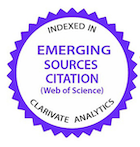METABOLIC PROFILE OF SANTA INÊS SHEEP IN DIFERENT STAGES OF PREGNANCY REARED IN SEMI-INTENSIVE SYSTEM IN STATE OF AMAZONIA
DOI:
https://doi.org/10.5216/cab.v15i1.15720Keywords:
Animal sanityAbstract
The aim of this study was to evaluate the nutritional metabolic condition of ewes at different stages of pregnancy. The analysis of the metabolic profile was through blood collection, using 30 sheep divided into three groups according to the stage of gestation (days): G1: between 50 and 60 days; G2: between 80 and 90 days, and G3: between 130 and 140 days. The analyzes of metabolites were performed by commercial kits. The concentrations of total protein, albumin, globulin and urea did not differ, except for urea, which showed increased levels. The mean glucose remained below the normal minimum value. For cholesterol, the means were 89.86 mg / dL, 86.01 mg / dL and 92.23 mg / dL for G1, G2 and G3, respectively. The animals of G1 and G2 presented statistically similar means for triglycerides, differing from G3 animals. The ?-hydroxybutyrate mean remained within the reference. Calcium levels were below the reference, showing the lowest level in G3 (8.86 mg/dL). Phosphorus levels decreased in G3. Any stage of pregnancy showed severe deficiencies in protein energy intake and diet, however requiring adequate calcium and phosphorus to the end of pregnancy.
KEYWORDS: Amazon; diet; metabolic deficit.Downloads
Published
How to Cite
Issue
Section
License
Copyright (c) 2014 Brazilian Animal Science/ Ciência Animal Brasileira

This work is licensed under a Creative Commons Attribution 4.0 International License.
Authors who publish with this journal agree to the following terms:
- Authors retain copyright and grant the journal right of first publication with the work simultaneously licensed under a Creative Commons Attribution License that allows others to share the work with an acknowledgement of the work's authorship and initial publication in this journal.
- Authors are able to enter into separate, additional contractual arrangements for the non-exclusive distribution of the journal's published version of the work (e.g., post it to an institutional repository or publish it in a book), with an acknowledgement of its initial publication in this journal.
- Authors are permitted and encouraged to post their work online (e.g. in institutional repositories or on their website) prior to and during the submission process, as it can lead to productive exchanges, as well as earlier and greater citation of published work (See The Effect of Open Access).































